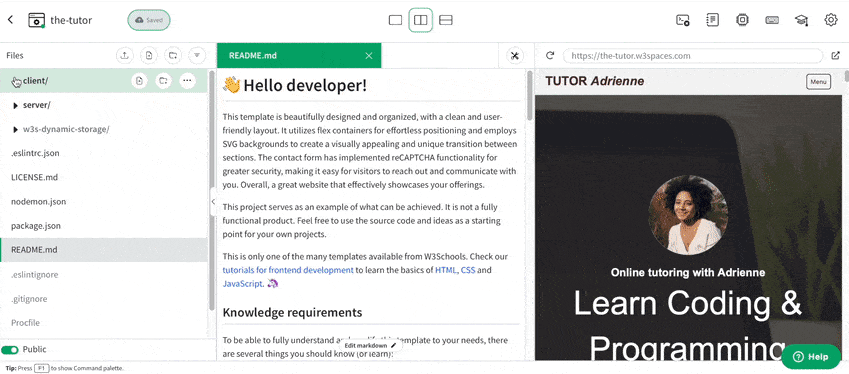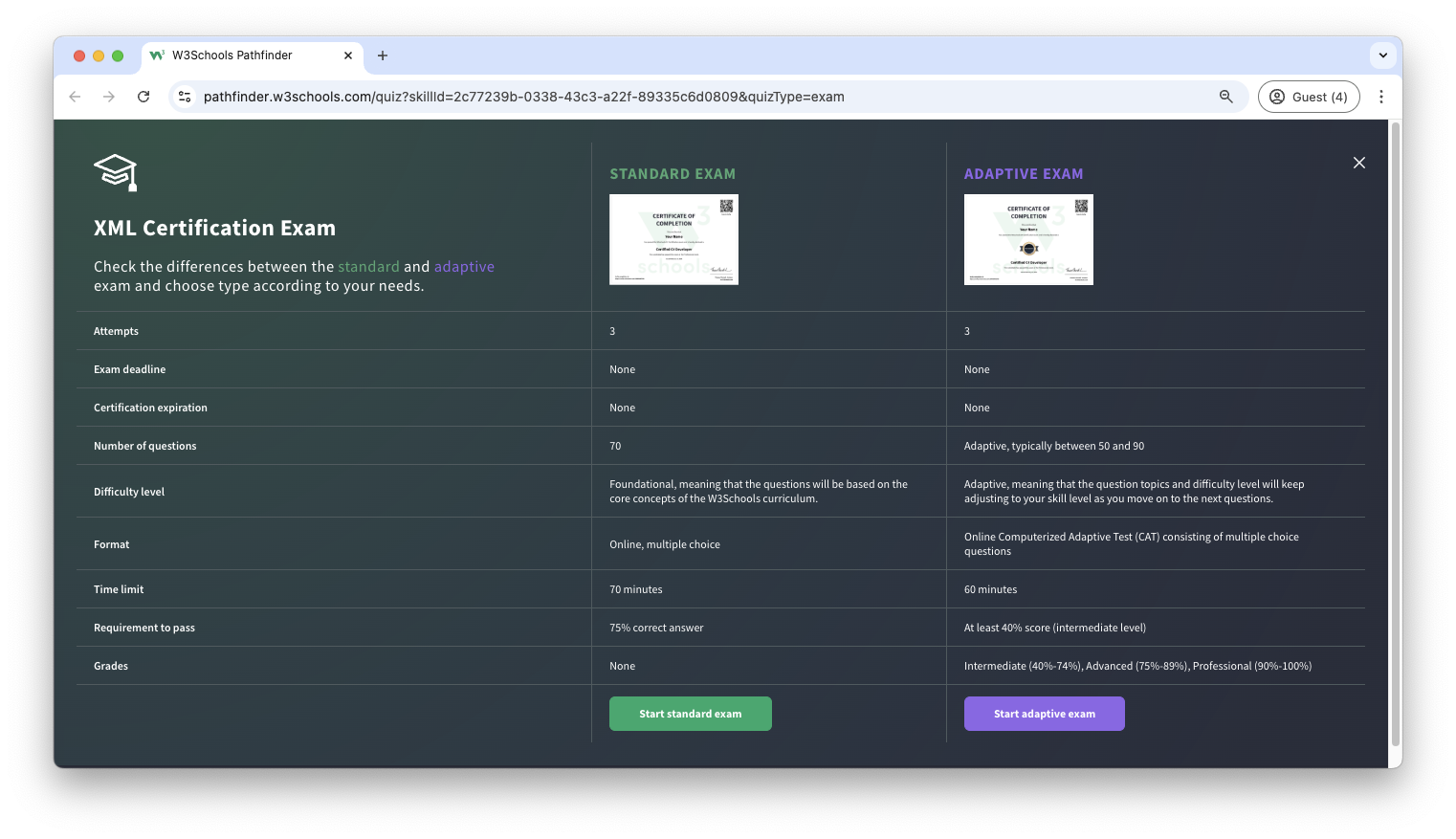XML Syllabus
Introduction
The W3Schools XML Tutorial is comprehensive and beginner-friendly.
It will give you a fundamental knowledge of XML.
It is designed for beginners and requires no prior experience with markup languages.
The content has been carefully made to be bite-sized, simple, and easy to understand.
The content has been proven by millions of users over the years. It is updated and improved frequently.
The syllabus outline and its sequence are structured so you can learn XML step by step, from the introduction to creating structured data.
Learning Outcomes
- Learn what XML is and how it works
- Create basic XML documents with elements and attributes
- Display XML data on web pages
- Use XML with AJAX for dynamic web content
- Work with XML DOM to access and change XML
- Use XPath to find information in XML documents
- Transform XML into other formats using XSLT
- Validate XML using DTD and XML Schema
- Store and share data using XML
Note: Are you a teacher teaching XML? W3Schools Academy is a toolbox of features that can help you teach. It offers classroom features such as pre-built study plans, classroom administration and much more. Read more about Academy here.
Which Subjects Are XML Relevant For?
- Data Exchange:
XML is essential for structured data exchange between systems. - Web Services:
XML is fundamental for SOAP web services and APIs. - Configuration:
XML is widely used for application configuration files. - Data Storage:
XML provides a format for storing structured data. - Document Management:
XML supports document structures and metadata. - System Integration:
XML enables communication between different systems. - Enterprise Applications:
XML is used in many enterprise-level applications.
Activities
In this tutorial we offer different activities for you to learn XML for free:
Sign in to Track Progress
You can also create a free account to track your progress.
As a signed-in user, you get access to features such as:
- Learning paths
- Sandbox and lab environments
- Achievements
- And much more!
Overview of the Modules
- XML HOME
- XML Introduction
- XML How to use
- XML Tree
- XML Syntax
- XML Elements
- XML Attributes
- XML Namespaces
- XML Display
- XML HttpRequest
- XML Parser
- XML DOM
- XML XPath
- XML XSLT
- XML XQuery
- XML XLink
- XML Validator
- XML DTD
- XML Schema
- XML Server
- XML Examples
- XML Quiz
- AJAX Introduction
- AJAX XMLHttp
- AJAX Request
- AJAX Response
- AJAX XML File
- AJAX PHP
- AJAX ASP
- AJAX Database
- AJAX Applications
- DOM Introduction
- DOM Nodes
- DOM Accessing
- DOM Node Info
- DOM Node List
- DOM Traversing
- DOM Navigating
- DOM Get Values
- DOM Change Nodes
- DOM Remove Nodes
- DOM Replace Nodes
- DOM Create Nodes
- DOM Add Nodes
- DOM Clone Nodes
- XPath Introduction
- XPath Nodes
- XPath Syntax
- XPath Axes
- XPath Operators
- XSLT Introduction
- XSL Languages
- XSLT Transform
- XSLT <template>
- XSLT <value-of>
- XSLT <for-each>
- XSLT <sort>
- XSLT <if>
- XSLT <choose>
- XSLT Apply
- XSLT on the Client
- XSLT on the Server
- XSLT Edit XML
- XQuery Introduction
- XQuery Example
- XQuery FLWOR
- XQuery HTML
- XQuery Terms
- XQuery Syntax
- XQuery Add
- XQuery Select
- DTD Introduction
- DTD Building Blocks
- DTD Elements
- DTD Attributes
- DTD Elements vs Attr
- DTD Entities
- XSD Introduction
- XSD How To
- XSD <schema>
- XSD Elements
- XSD Attributes
- XSD Restrictions
- XSD Complex Elements
- XSD Empty
- XSD Elements-only
- XSD Text-only
- XSD Mixed
- XSD Indicators
- XSD <any>
- XSD <anyAttribute>
- XSD Substitution
- XSD String
- XSD Date/Time
- XSD Numeric
- XSD Misc
- XML Services
- XML WSDL
- XML SOAP
- XML RDF
- DOM Node Types
- DOM Node
- DOM NodeList
- DOM NamedNodeMap
- DOM Document
- DOM Element
- DOM Attribute
- DOM Text
- DOM CDATA
- DOM Comment
- DOM XMLHttpRequest
- DOM Parser
- XSLT Elements
- XSLT/XPath Functions
Sandbox and Lab Environment
XML, like any markup language, is best learned through hands-on practice.
Try this example using our editor:
XML Example 1
<?xml version="1.0" encoding="UTF-8"?>
<note>
<to>Tove</to>
<from>Jani</from>
<heading>Reminder</heading>
<body>Don't forget me this weekend!</body>
</note>
If you want to explore more and host your project, we have a feature called Spaces that allows you to build, test and validate XML documents for free.
Here you get a secure sandbox environment called Spaces, where you can practice XML and test documents in real-time.
Spaces allow you to test, validate, and transform XML. This includes a W3Schools subdomain, hosting, and secure SSL certificates.
Spaces require no installation and run directly in the browser.
Features include:
- Collaboration
- File navigator
- Terminal & log
- Package manager
- Database
- Environment manager
- Analytics

XML Certification
W3Schools offers an end-of-pathway certification program.
Here you can take exams to get certified.
The XML exam is a test that summarizes the W3Schools XML syllabus.
After passing the exam you get the "Certified XML Developer" Certification.
There are two different types of certifications:
- Non-adaptive
- Adaptive
The non-adaptive is pass or no pass.
The adaptive certification is adaptive and graded; students will get a grade from intermediate, advanced to professional.
Are You a Teacher?
Are you interested in learning how you can use W3Schools Academy to Teach XML?
Watch a demo of W3Schools Academy. You'll see how it works, and discover how it can make teaching programming easier and more engaging.



